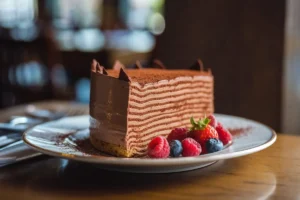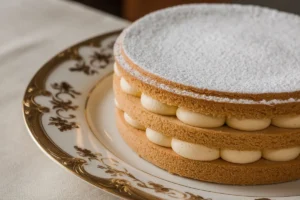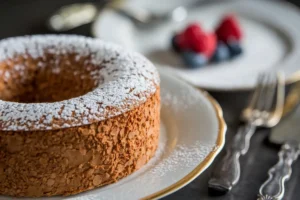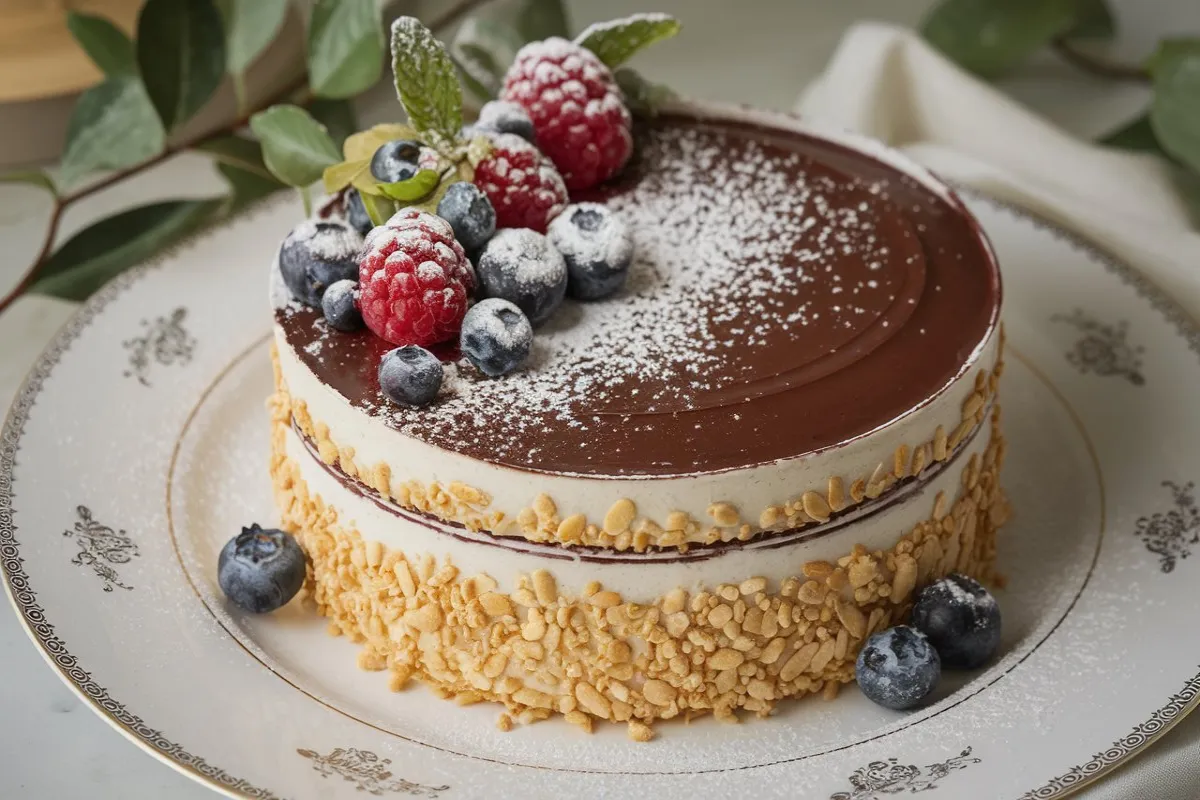As you explore French language and culture, you quickly discover that many words carry deeper meanings. One such word is gâteau. While it translates to “cake” in English, gâteau has much greater cultural significance in France. This article explains the meaning of gâteau, its origins, different types, and how people use it in both culinary contexts and everyday language.
Introduction to the Word Gâteau
The French word gâteau translates directly to “cake” in English. However, it represents more than just a sweet dessert in French culture. The term covers a range of confections, often elaborate, rich, and deeply rooted in the tradition of French patisserie.
Understanding gâteau means recognizing its place in French culinary heritage and its role in the language. Whether you’re exploring a French patisserie or discussing French culture, knowing the nuances of gâteau will deepen your appreciation for this sophisticated term.
The Literal and Cultural Meaning of Gâteau
In its basic sense, gâteau refers to a cake. This could be a simple sponge cake, a decorated birthday cake, or an elaborate dessert with layers of cream, mousse, or fruit. But in French, the word often describes desserts that go beyond what English speakers consider “cake.”
- Literal Translation
- The word gâteau means cake, but in French culinary tradition, it often suggests something more intricate. In many French homes, a gâteau is not just a dessert; it’s a centerpiece for celebrations like birthdays, weddings, or any festive event.
- Cultural Interpretation
- In France, gâteau symbolizes a moment of indulgence, a treat saved for special occasions. The variety of gâteaux available in French patisseries reflects the country’s rich culinary history, with each region boasting its own traditional cakes. For example, the Gâteau Basque, from the Basque region, is a beloved dessert showcasing local flavors and ingredients.
Historical Background of Gâteau
The origins of gâteau are as rich and layered as the desserts themselves. The term has evolved over centuries, reflecting changes in French culinary practices and societal norms.
- Etymology of Gâteau
- The word gâteau comes from the Old French term “gastel,” which referred to a small cake or loaf of bread. As French cuisine developed and became more refined, gâteau began to describe elaborate and rich cakes, often featuring layers of sponge, cream, and fruit.
- Evolution in French Cuisine
- Over time, gâteaux have played a key role in French culinary tradition. From medieval feasts to modern patisseries, these desserts have changed in both form and purpose. Today, they range from simple homemade cakes to intricate creations that require the skill of a master pastry chef.
- Cultural Significance
- In French culture, a gâteau is more than just a dessert. It’s often the highlight of a meal, especially during celebrations like weddings, birthdays, and holidays. Many French families take pride in the beauty and craftsmanship of their cakes. Learn more about the cultural significance of gâteau in this detailed overview.
Types of Gâteaux in French Cuisine

French cuisine is famous for its diverse and exquisite gâteaux. Each type of gâteau has its own preparation methods, ingredients, and regional variations.
- Classic French Gâteaux
- Gâteau au Chocolat: A classic chocolate cake that is both rich and moist, often made with dark chocolate and topped with a glossy ganache.
- Gâteau St. Honoré: Named after the patron saint of bakers and pastry chefs, this elaborate cake features puff pastry, choux pastry, and caramelized sugar, topped with whipped cream and a hint of vanilla.
- Regional Variations
- Gâteau Basque: A traditional cake from the Basque region, typically filled with either pastry cream or black cherry jam. It’s a dense, buttery cake that represents the rustic charm of the Basque countryside.
- Gâteau Breton: From Brittany, this cake is known for its rich, buttery flavor. It’s a simple cake, often compared to shortbread, with a tender crumb and a slight hint of salt from the Breton butter.
- Modern Interpretations
- Contemporary French patisseries continue to push the boundaries of traditional gâteaux, experimenting with flavors like matcha, exotic fruits, and even savory ingredients. These modern interpretations maintain the elegance and sophistication of classic French baking while introducing new tastes and textures.
The Difference Between Gâteau, Cake, and Torte
Understanding the differences between gâteau, cake, and torte is crucial for anyone interested in baking or French cuisine.
- Gâteau vs. Cake
- While gâteau is often translated as “cake,” it usually refers to something more intricate and luxurious in French culinary tradition. A gâteau might include layers of sponge cake, cream, mousse, and fruit, all beautifully decorated and carefully prepared. In contrast, the English word “cake” is a broader term that can refer to anything from a simple sheet cake to a more elaborate dessert.
- Gâteau vs. Torte
- A torte is similar to a gâteau but is typically denser and richer. Tortes often contain little or no flour, relying instead on ground nuts or breadcrumbs for texture. While both gâteaux and tortes are associated with high-end baking, tortes tend to be more compact and intensely flavored.
Usage of Gâteau in French Language
The word gâteau isn’t limited to the kitchen; it also appears in everyday French language, often in the form of idiomatic expressions.
- Common Phrases
- C’est du gâteau!: This phrase, which translates to “It’s a piece of cake!” in English, describes something easy to do. The expression shows the versatility of the word gâteau in French, extending its meaning beyond the culinary realm.
- Gâteau de mariage: This term refers to a wedding cake, often a grand and elaborate confection that highlights any French wedding reception.
- Literature and Media
- The word gâteau often appears in French literature and media, symbolizing indulgence, luxury, or ease. For example, in Marcel Proust’s famous novel À la recherche du temps perdu (In Search of Lost Time), the protagonist’s memories are triggered by the taste of a madeleine, a small cake similar to a gâteau. This scene shows the deep connection between food and memory in French culture.
Nutritional Aspects of Gâteau

While gâteaux are delicious, they are often high in calories and sugar. However, understanding their nutritional content can help you enjoy them in moderation.
- Typical Ingredients
- Traditional gâteaux are made with rich ingredients like butter, sugar, eggs, and flour. Many also include cream, chocolate, and fruits, which add to their luxurious texture and flavor. The use of high-quality ingredients is a hallmark of French patisserie, ensuring that every bite of a gâteau is a decadent experience.
- Health Considerations
- Due to their high-calorie content, gâteaux should be enjoyed in moderation. However, many bakers today are experimenting with healthier alternatives, such as using whole-grain flours, reducing sugar content, or incorporating fruits and nuts for added nutrition. These variations allow you to indulge in a gâteau without the guilt, while still savoring the rich flavors that make French desserts so irresistible.
FAQs About Gâteau
Given its cultural and culinary significance, it’s no surprise that people have many questions about gâteau. Here are some of the most commonly asked questions:
- What is the difference between gâteau and cake?
- Gâteau generally refers to a more elaborate and luxurious dessert than what might be considered a “cake” in English. While both terms can refer to similar baked goods, gâteau often implies a level of sophistication and complexity that sets it apart.
- How do you pronounce “gâteau”?
- The word gâteau is pronounced as “ga-toe,” with the emphasis on the first syllable. It’s a simple pronunciation, but mastering it can help you sound more authentic when discussing French cuisine.
- What is a traditional French gâteau?
- A traditional French gâteau might be something like the Gâteau Basque or Gâteau St. Honoré, both of which have deep roots in French culinary history. These cakes are typically made with high-quality ingredients and are designed to be both beautiful and delicious.
- What are the most popular types of gâteau in France?
- Some of the most popular gâteaux in France include Gâteau au Chocolat, Gâteau Basque, and Gâteau Breton. Each of these cakes is beloved for its unique flavor and texture, and they all play an important role in French culinary tradition.
- Can “gâteau” refer to something other than food?
- Yes, in French, the word gâteau can also be used metaphorically. For example, the phrase “C’est du gâteau!” means that something is easy to do, much like the English expression “It’s a piece of cake.”

Conclusion
In conclusion, the word gâteau holds a special place in both the French language and French culinary tradition. Whether you’re enjoying a slice of gâteau at a café in Paris or using the word in conversation, understanding its full meaning and significance can deepen your appreciation for French culture.
From its historical roots to its modern-day interpretations, gâteau is a word that embodies the elegance, sophistication, and indulgence of French cuisine. So the next time you savor a gâteau, remember that you’re not just eating a cake—you’re experiencing a piece of French history and culture.

